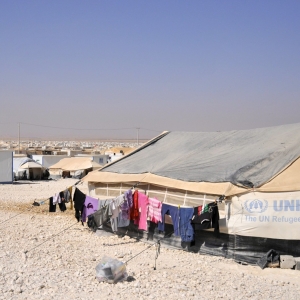Federal Water Tap, March 23: Defense Department Investigates Hundreds More Military Sites for Possible PFAS Contamination
The Rundown
The cost and scope of the Defense Department’s PFAS contamination expands. A Florida representative proposes a tax on pumping groundwater and spring water for bottled drinking water. NOAA forecasters say that 23 states have an elevated flood risk this spring. And lastly, the Army Corps, at President Trump’s request, withdraws a water supply rule for the reservoirs it manages.
“EPA recommends that citizens continue to use and drink tap water as usual. At this time, there are no indications that COVID-19 is in the drinking water supply or will affect the reliable supply of water.” — Message from the U.S. Environmental Protection Agency, based on guidance issued by the World Health Organization.
In context: As Cities Suspend Shutoffs, Water Access and Hygiene at Front of Coronavirus Response
By the Numbers
250: Additional sites, as of the end of last September, that the military is investigating for potential releases of PFAS chemicals to the environment. The total number of sites now reaches 651. (Defense Department)
News Briefs
Water Extraction Tax
Rep. Debbie Wasserman Schultz (D-FL) proposed legislation that would levy a tax on companies that pump groundwater or spring water for bottling.
The tax revenue — six cents per gallon — would be directed to the federal government’s main loan program for drinking water and sewer infrastructure.
Army Corps Water Supply Rule
At the direction of President Trump, the Army Corps of Engineers officially withdrew a proposed water supply rule.
The rule would have regulated municipal and industrial water use from reservoirs managed by the Corps. It was proposed during the Obama administration and criticized by governors, who felt that it infringed upon their authority.
The rule withdrawal became official on March 23.
Studies and Reports
Defense Department Investigates More Sites for PFAS Contamination
The Defense Department says that, as of the end of last September, the number of sites it is investigating for potential release of toxic PFAS chemicals to the environment has grown from 401 to 651.
The new figure was inserted into a progress report from the department’s PFAS task force. Forming the task force was one of the first actions that Mark Esper took after being confirmed as defense secretary last July.
Most of the contamination can be traced to the use of firefighting foams that contain the manmade chemicals.
One of the task force’s aims is to assess the use of firefighting foams that do not contain PFAS chemicals. This is easier said than done. No PFAS-free foams currently exist that meet the military’s firefighting specifications, according to the report.
When such foams are available, the price of adaptation could be high. Scrubbing and retrofitting existing firefighting vehicles in order to incorporate new foams could mean replacing nearly every part of the vehicle, the report states. In that case, buying new vehicles instead might be necessary — at a cost of $4 billion to $6 billion over 18 years. The timeline would be determine by production capacity and the needs of commercial airports, which have their own vehicle fleets to replace.
In context: Nonstick Chemicals Slipped into Water, Causing Health, Environmental, Regulatory Mess
On the Radar
Spring Flooding Outlook
Minnesota, North Dakota, and South Dakota have the highest flood risk this spring, according to National Oceanic and Atmospheric Administration forecasters.
There is an elevated flood risk in 23 states, mostly in the Mississippi River basin, but also in Alabama and Georgia.
The 2019 flood season broke records along the Missouri and lower Mississippi rivers. High waters breached dams in Nebraska, inundated homes in Missouri, and prevented farmers from planting at least 16 million acres of corn and soybeans.
Wet conditions have continued through the winter and soils are still saturated, setting the region up for another round of flooding.
Federal Water Tap is a weekly digest spotting trends in U.S. government water policy. To get more water news, follow Circle of Blue on Twitter and sign up for our newsletter.
Brett writes about agriculture, energy, infrastructure, and the politics and economics of water in the United States. He also writes the Federal Water Tap, Circle of Blue’s weekly digest of U.S. government water news. He is the winner of two Society of Environmental Journalists reporting awards, one of the top honors in American environmental journalism: first place for explanatory reporting for a series on septic system pollution in the United States(2016) and third place for beat reporting in a small market (2014). He received the Sierra Club’s Distinguished Service Award in 2018. Brett lives in Seattle, where he hikes the mountains and bakes pies. Contact Brett Walton





Leave a Reply
Want to join the discussion?Feel free to contribute!